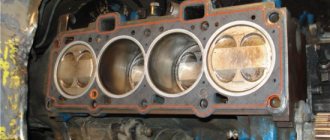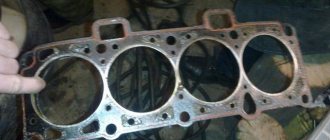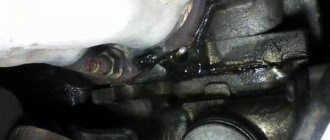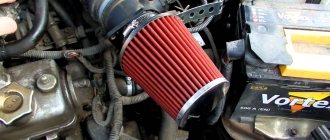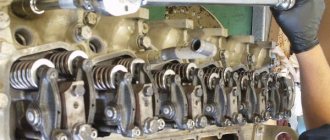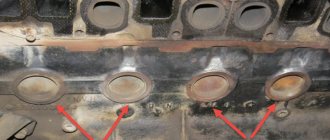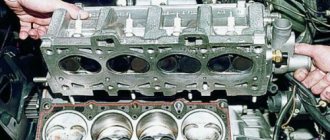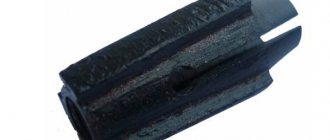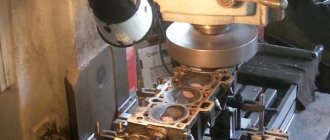A special cylinder head gasket is used to seal the connection between the cylinder block and the cylinder head. It has holes for: lag bolts, passage of coolant and engine oil from the cylinder block into the cylinder head, as well as lining the combustion chambers.
Due to the fact that increased demands are placed on this consumable, it contains metal rings located at the point of contact of the cylinder head gasket with the combustion chamber and protecting it from the combustion temperatures of the fuel mixture and, as a result, premature wear.
What it is
The gasket is used to seal the contact point between the cylinder head and the block itself. Some people don't know the difference between valve cover and cylinder head gaskets. These are different parts, although they are located nearby.
What is a cylinder head gasket
The peculiarity of the seal is that it is capable of performing three important functions at once - sealing the gas distribution and oil systems, as well as the car’s engine cooling system. Therefore, the gasket must be strong enough and there are such high requirements for it.
Cylinder head gasket
Note! The cylinder head gasket must be changed for all types of engine repairs, since it is a one-time use item.
Price issue
Changing the head gasket yourself will be quite inexpensive, since its cost ranges from 220 (for 8-valve engines) to 550 rubles (for 16-valve engines). In addition to it, you will need a gasket between the exhaust pipe and the catalyst, which costs no more than 100 rubles, and 10 new head bolts, costing 40–50 rubles each. Often the manifold gasket is damaged, which in this case must be replaced. A new part costs about 750 rubles. The total cost of spare parts will not exceed 1,500 rubles. It must be remembered that when disassembling and troubleshooting the engine, other parts may appear that need to be replaced.
Performing such work at a service station depends on the territorial location and ranges from 4 thousand rubles in small cities (Tula, Bryansk) and up to 10 thousand rubles in large cities (Moscow, St. Petersburg).
Classification
There are three types of seals, classified according to the material of manufacture. These are non-asbestos, asbestos and metal gaskets. Let us now consider each of the types separately.
Non-asbestos
Such seals are characterized by low shrinkage. In addition, non-asbestos material has high recoverability, which is important for specific conditions of use.
Non-asbestos gasket
Asbestos
The product has much in common with non-asbestos gaskets in terms of characteristics. Asbestos seals have high elasticity, heat resistance and elasticity. Such gaskets are often used when replacing.
Asbestos gasket
Metal
Metal seals are considered the most effective and high-quality type of cylinder head gaskets. When using them, the pressure is distributed evenly over the entire plane of the junction of the block and the cylinder head.
Metal cylinder head gasket
Articles on the topic
How to change spark plugs
Changing the automatic transmission oil
Important nuances of the replacement procedure
I can’t say that the car owner himself won’t cope with this task. There are a number of clear examples where a motorist, after watching the video, changed the gasket himself and did everything no worse than the service station technicians.
But you should be prepared for the difficulties and duration of the operation. Having experience will only be beneficial, but lacking it can negatively affect the results.
Before replacement, several preparatory work is carried out. Namely:
- the car is de-energized;
- all antifreeze is drained;
- the timing belt or chain is removed;
- all internal combustion engine elements associated with the cylinder head are disconnected;
- The cover itself is removed.
I’ll say right away that there are no universal instructions. Each engine, even within identical cars of an identical year of manufacture, is accompanied by special instructions for replacing the gasket. You need to rely strictly on it, and nothing else.
Having removed the block head, the old sealing gasket is dismantled and checked for visual defects. If the integrity is truly broken, this is not yet a reason to rejoice and start replacing. There are various reasons why the gasket became deformed. First you need to determine why this happened, eliminate the provoking factor, and only then change the part.
It is important to carefully inspect the surfaces of the cylinder head and cylinder head with which they are adjacent to each other during assembly.
Even when the gasket turns out to be intact, and the reason for the leak is different, the old seal cannot be reused. The element has already lost its shape, and therefore a strictly new spare part of the appropriate size and dimensions is needed.
Also, as part of replacing the gasket, the mounting bolts are changed. They constantly work under load and are tightened under the influence of enormous force. As a result, during operation, the metal is pulled out and the fastening geometry is lost.
This is interesting: What kind of bulbs are in the foglights on the Hyundai Solaris
During reassembly, a specific tightening sequence is followed. Plus, the applied force is strictly dosed. In this case, you cannot do without a torque wrench. It is definitely included in any tool kit for a motorist, and is an integral part of those who prefer to repair and maintain their cars with their own hands.
Have you ever encountered a blown gasket? How did you fix this problem and were you able to cope with the replacement yourself?
In what cases is replacement necessary?
If we talk about the cylinder head gasket, it does not have a warranty period, since the service life of the part actually depends on several factors (driving habits, product manufacturer and engine condition). Therefore, the need for replacement may be indicated by symptoms identified by the driver during periodic checks or maintenance.
Signs of cylinder head gasket wear
There are many telltale signs of seal wear. Let's look at the most common of them:
- sudden overheating of the engine;
- decrease in coolant level in the system;
- the appearance of foam or emulsion on the oil dipstick;
- an increase in pressure in the cooling system lines (the pipes become too hard);
- traces of oil leakage at the junction of the block and cylinder head;
- antifreeze boiling after prolonged engine operation;
- problems with the operation of the stove (the operation of the heat exchanger is disrupted by escaping exhaust gases).
Signs of a broken cylinder head gasket
On a note! It is also necessary to change the cylinder head seal in cases where white smoke begins to come out of the engine compartment.
How can you determine on your own that replacing the cylinder head gasket is inevitable?
- High consumption of coolant (coolant).
- The appearance of oil stains on the surface of the coolant in the tank.
- There is a grease leak at the joint. Coolant enters through the damaged gasket and forms white foam.
- The color of the exhaust gases turns white - coolant has entered the cylinder.
- Exhaust gases enter the cooling system.
This is noticeable by the appearance of bubbles in the tank or radiator. Operating a vehicle with a faulty gasket can cause a number of other problems: - Burst of pipes due to high pressure.
- Engine overheating and loss of cylinder head seal.
- Engine jamming. This malfunction occurs due to poor lubrication of the rubbing elements, as well as due to water hammer. Such repairs cost almost the same as a major engine overhaul.
That is why experts recommend that vehicle owners do not operate equipment with a faulty cylinder head gasket.
Diagnostic features
Everything mentioned above is circumstantial evidence. But to confirm the diagnosis, detailed diagnostics are required. Below are sequential instructions.
- Start the engine and inspect it for smoke leaks. Particular attention should be paid to the gaps between the block and the cylinder head.
- Inspect the oil filler neck. If the seal breaks, reddish traces of the emulsion will be visible on the neck.
- Check to see if white smoke is coming from the muffler. The presence of white smoke from the exhaust system is usually indicated by a burned-out cylinder head gasket. The smoke is most often sweet.
- Place a balloon on the neck of the radiator. If the ball inflates while the engine is running, this indicates bubbling of the antifreeze and, accordingly, a violation of the integrity of the seal.
- Check engine compression. If the level is below normal, then the gasket probably needs to be changed.
Condom for checking cylinder head gasket
After diagnostics, you can easily determine whether the cuff needs to be replaced. Then everything is done according to the instructions.
Cylinder head gasket VAZ 2107
The cylinder head gasket is a one-time use item, since its physical properties and geometry change during installation.
What is the cylinder head gasket used for?
The cylinder head gasket is designed to seal the connection between the cylinder block and the head. Even taking into account the fact that these engine components have perfectly flat mating planes, it will not be possible to achieve complete tightness without it, because the pressure in the combustion chambers reaches more than ten atmospheres. In addition to this, the seals also require connection of the oil channels, as well as the cooling jacket channels. Tightness is achieved by uniform compression of the gasket while tightening the connecting elements.
The gasket serves to seal the connection between the head and cylinder block
What are cylinder head gaskets made of?
The cylinder head gasket can be made of different materials:
- metal (copper and aluminum alloys);
- asbestos;
- combinations of metal and asbestos;
- combinations of rubber and asbestos;
- paronitis.
The main requirements for the gasket are resistance to high temperatures and ability to compress. Each of the listed materials has its pros and cons. Products made from multiple layers of metal or asbestos, for example, better withstand high temperatures, but may not provide the best seal. Parts made of rubber and paronite, on the contrary, maximize the connection between the head and the block, but their temperature stability is lower.
Metal cylinder head gaskets for VAZ 2107 are made from copper and aluminum alloys
When choosing a gasket, it is better to give preference to a combined product, for example, made of asbestos and metal. Such seals are made of sheet asbestos, but the holes for the cylinders are reinforced with metal rings. Holes for fastening elements are reinforced with the same rings.
When choosing a gasket, it is better to give preference to a combined product
What to consider when choosing a cylinder head gasket
If you are going to replace the gasket, you need to know exactly the characteristics of the engine. The fact is that the “sevens” were equipped with three types of power plants: VAZ 2103, 2105 and 2106, which have different cylinder diameters. For the first it is 76 mm, for the last two it is 79 mm. Gaskets are manufactured according to these dimensions. Therefore, if you purchase a cylinder head seal for a 2103 engine and install it on a 2105 or 2106 power unit, the pistons will naturally tear the edges of the product with all the ensuing consequences. If a gasket with a cylinder hole diameter of 79 mm is installed on a VAZ 2103 engine, the seal will not provide the necessary tightness due to the fact that the part will not completely block the cylinder holes.
Causes and signs of cylinder head gasket failure
The destruction of the seal is characterized by its breakdown or burnout. In the first case, there is slight damage to the part, which in some cases cannot even be seen with the naked eye. When a product burns, the scale of damage is significantly greater. The part is deformed and loses its integrity, leaving joint areas without sealing.
Causes of destruction
The main reasons why a cylinder head gasket fails prematurely include:
- overheating of the power unit;
- incorrect order or tightening torque of the mounting bolts during installation;
- factory defects or low quality materials used to manufacture the part;
- use of low-quality coolant;
- engine malfunctions.
Engine overheating most often causes gasket failure. It usually occurs due to interruptions in the operation of the cooling system (malfunction of the thermostat, radiator fan, fan switch sensor, clogged radiator, etc.). As soon as the driver drives a car with an overheated engine for half a kilometer, the gasket will burn out.
When installing a new seal on a power unit being repaired, it is important to follow the order of tightening the bolts that secure the head to the block. In addition, it is necessary to adhere to the specified tightening torque of the fastening elements. If the bolts are not tightened or overtightened, the gasket will inevitably become deformed and subsequently be punctured.
Most often, the gasket burns out due to engine overheating.
When choosing a replacement seal, you should pay attention not only to its parameters, but also to the manufacturer. Under no circumstances should you buy cheap parts from unknown companies. The result of such savings may be unplanned engine overhauls. This also applies to coolant. Low-quality refrigerant can cause corrosion and damage not only the gasket, but also the head itself.
As for disturbances in the operation of the power plant, processes such as detonation and glow ignition also have a destructive effect on the seal. Therefore, it is worth monitoring the quality of the fuel and the correct adjustment of the ignition timing.
Signs of cylinder head gasket damage
A breakdown or burnout of the gasket can manifest itself in the form of:
- rapid heating and overheating of the engine;
- unstable operation of the power unit;
- oil or coolant leaks from under the cylinder head;
- traces of coolant in the oil and grease in the refrigerant;
- steam in exhaust gases;
- an increase in pressure in the cooling system, accompanied by the appearance of smoke in the expansion tank;
- condensation on the spark plug electrodes.
Symptoms will be different in each individual case. It depends on where exactly the integrity of the seal was damaged. If the gasket is damaged near the edge of the cylinder bore, then, most likely, the power plant will overheat with an increase in pressure in the cooling system. In this case, hot exhaust gases under pressure will break through the seal damage into the cooling system. Naturally, antifreeze or antifreeze will begin to heat up quickly, increasing the temperature of the entire engine. This will increase the pressure in the system, and gas bubbles will appear in the expansion tank.
When a gasket burns out, refrigerant often gets into the oil.
There will definitely be a reverse effect. If coolant enters the combustion chambers, it will disrupt the normal operation of the engine. The engine will begin to stall due to the fact that the fuel-air mixture, diluted with coolant, will not be able to burn. As a result, we will get a noticeable malfunction of the engine at idle, accompanied by exhaust gases in the cooling system, coolant in the combustion chambers and thick white smoke with a characteristic odor from the exhaust pipe.
If the gasket burns out somewhere between the windows of the cooling jacket and the oil channels, it is possible that these two process fluids will mix. In this case, traces of grease will appear in the expansion tank, and antifreeze or antifreeze will appear in the oil.
Oil may get into the cooling system
If the gasket is damaged along the edge, oil or coolant leakage is usually observed at the junction of the cylinder head and the cylinder block. In addition, a breakthrough of exhaust gases between the main engine parts is also possible.
If the gasket is damaged and coolant is leaking into the cylinders, thick white smoke will come out of the exhaust pipe.
Self-diagnosis
Diagnosis of gasket failure must be approached comprehensively. In other words, you should not immediately start removing the head when you see white smoke from the exhaust pipe or oil leaks from under the head. To verify that the seal is faulty, follow these steps:
- Inspect the junction of the head and cylinder block around the perimeter. If you find oil or coolant leaks, make sure that it is leaking from under the head.
- Start the engine and notice the color of the exhaust and its smell. If it really looks like thick white steam and smells like antifreeze or antifreeze, turn off the engine and carefully unscrew the expansion tank cap. Take a sniff. If exhaust gases enter the cooling system, the smell of burnt gasoline will come from the tank.
- Without tightening the cap of the expansion tank, start the engine and look at the condition of the refrigerant. It should not contain any gas bubbles or traces of lubricant.
- Turn off the power plant and let it cool. Remove the oil dipstick, inspect it and determine the oil level. If there are traces of a white-brown emulsion on the dipstick, or the oil level has suddenly risen, mixing of process fluids is taking place.
- Let the engine run for 5-7 minutes. Silence it. Unscrew the spark plugs and inspect the electrodes. They must be dry. If there are traces of moisture on them, most likely, refrigerant is entering the cylinders.
Video: signs of cylinder head gasket damage
How to replace a cylinder head gasket
The process of replacing the gasket can be divided into several stages: preparation, collecting the necessary tools for work and replacing the seal. Now let's look at each of these stages separately.
Replacing the cylinder head gasket
Preparation
The technology for replacing the gasket does not depend on the car model, with the exception of some features (tightening torque of the mounting bolts). But all information can be found in the instruction manual or on the Internet. It is advisable to clean all bolts before unscrewing so as not to damage the splines. Also, if necessary, they need to be treated with a special agent to make them easier to break.
Preparing to replace the cylinder head gasket
Note! All attachments must be removed before replacement. The cylinder head should also be removed
Tools for work
What is needed for the job, besides the cylinder head gasket itself? First of all, before starting repair work you should prepare:
- torque wrench;
- a clean rag;
- container for draining waste liquid;
- flat and Phillips screwdrivers;
- set of wrenches (socket and wrench).
Tools for replacing cylinder head gasket
You also need to prepare a set of new cylinder head bolts in case the old ones are too worn out. Once everything is at hand, you can start replacing.
Step-by-step instructions for replacing the cylinder head gasket
The instructions below describe in detail the process of replacing the cylinder head gasket. If this is followed, the complex and lengthy replacement process will be within the capabilities of even a beginner.
Step 1: Raise the hood and get your tools ready for the job. This is what the engine compartment looks like before disassembly.
Engine compartment before disassembly
Step 2: Remove the plastic protective cover and set it aside. You need a key for this.
Removing the protective cover
Step 3: Remove the timing belt and inspect it for integrity.
Removing the timing belt
Step 4. Drain the antifreeze into a prepared container. This could be a cut plastic bottle or canister. Make sure that liquid does not get on the car body.
Draining antifreeze into a special container
Step 5. Remove the cylinder head cover bolts.
Unscrewing the cylinder head cover bolts
Step 6. As you can see in the photo, the gasket is worn out and requires replacement. Take it off.
Worn cylinder head gasket
Step 7. Remove the cylinder head and carefully place the part on a table or other flat surface.
Removing the cylinder head
Step 8. Thoroughly clean the seat of any remaining oil.
Cleaning the seat
Step 9. After cleaning the surface, install a new gasket.
Installing a new cylinder head gasket
Step 10: Install the cylinder head using a torque wrench. You need to tighten it carefully, according to the manufacturer's recommendations.
Cylinder head installation
Step 11. Install the casing and all previously removed parts in reverse order.
Installing the protective cover
Why does the cylinder head gasket wear out and how to check its condition?
Without exaggeration, the seal can be called the most important element of the cylinder head. There is no need to save money on replacing the gasket, because such attempts will ultimately result in serious engine damage. It is important to understand that this is a disposable material that requires replacement after any manipulation of the cylinder head. The following types of gaskets are known today:
- Non-asbestos – they are characterized by low collapse and high reproducibility
- Asbestos - reliable, plastic, able to withstand the high temperatures that prevail in the car system
- Metal ones are the most expensive type, but this makes them the most reliable. Many experts recommend installing them instead of conventional
It is almost impossible to visually assess the condition of the cylinder head gasket. To assess the ability of its further functioning, the factory and current fuel consumption for every 100 km are compared, and engine operation is diagnosed. Short trips in a car with a worn gasket can lead to serious consequences: the engine of a car with low mileage, but with an unsuitable cylinder head seal, in advanced cases, can only be revived through major repairs.
We note the following reasons for premature wear of the seal:
- Incorrect installation of elements during cylinder head assembly
- Prolonged overheating of the motor
- Operating a vehicle using low quality fuel
Engine overheating is the most common cause of gasket failure. An increase in the operating temperature of the power unit is observed during cooling system malfunctions and detonations. Even asbestos material cannot withstand critical temperatures, losing its strength, elasticity and many other important characteristics over time. The loss of its functional properties leads to blowing and complete destruction of the material.
Consequences of untimely replacement
It is undesirable to operate a car with a worn or burned out cylinder head gasket, as this can lead to serious consequences. For example, oil will get into the cooling system, causing its operation to be disrupted. The motor will not be able to cool as needed. The engine power may also decrease, it will begin to stall, and sometimes not start at all.
Late replacement of the cylinder head gasket
If antifreeze gets into the cooling system, the properties of the oil will change, which will lead to a decrease in the efficiency of lubrication of engine parts. In turn, this will lead to increased wear of rubbing parts. Driving a car with a damaged gasket will certainly lead to engine failure, the repair of which will cost much more than replacing the seal.
Signs and causes of malfunction
It is possible to give a 100% guarantee that the element has failed only upon dismantling and visual inspection. Usually, wear of the seal between the cylinder head and cylinder head will manifest itself in the form of symptoms, potentially indicating more serious problems.
In practice, replacement is performed on many machines. Mainly on cars that have been in use for a long time. Let me give you a few examples:
- VAZ 2106;
- VAZ 2107;
- Nissan Maxima;
- Opel Zafira;
- Chevrolet Niva;
- VAZ 2110;
- 2114;
- VAZ 2112;
- Daewoo Nexia;
- Renault Logan;
- Hover M4;
- Peugeot 406;
- Reno 19;
- BMW E39;
- UAZ Hunter, etc.
Moreover, wear and breakdown of the gasket are equally typical for engines with 8 valves and 16 valves. There is no fundamental difference in terms of the behavior of the BC gaskets between them.
However, the cost of a new part can vary significantly depending on the make, model of the car and the specific engine installed.
There are several reasons why the seal needs to be changed:
- there was oil in the cooling system;
- coolant has entered the oil system;
- antifreeze got inside the combustion chamber;
- Exhaust gases enter the cooling system.
This is all what can happen precisely when the seal between the two main structural elements of the engine is broken.
The symptoms are as follows:
